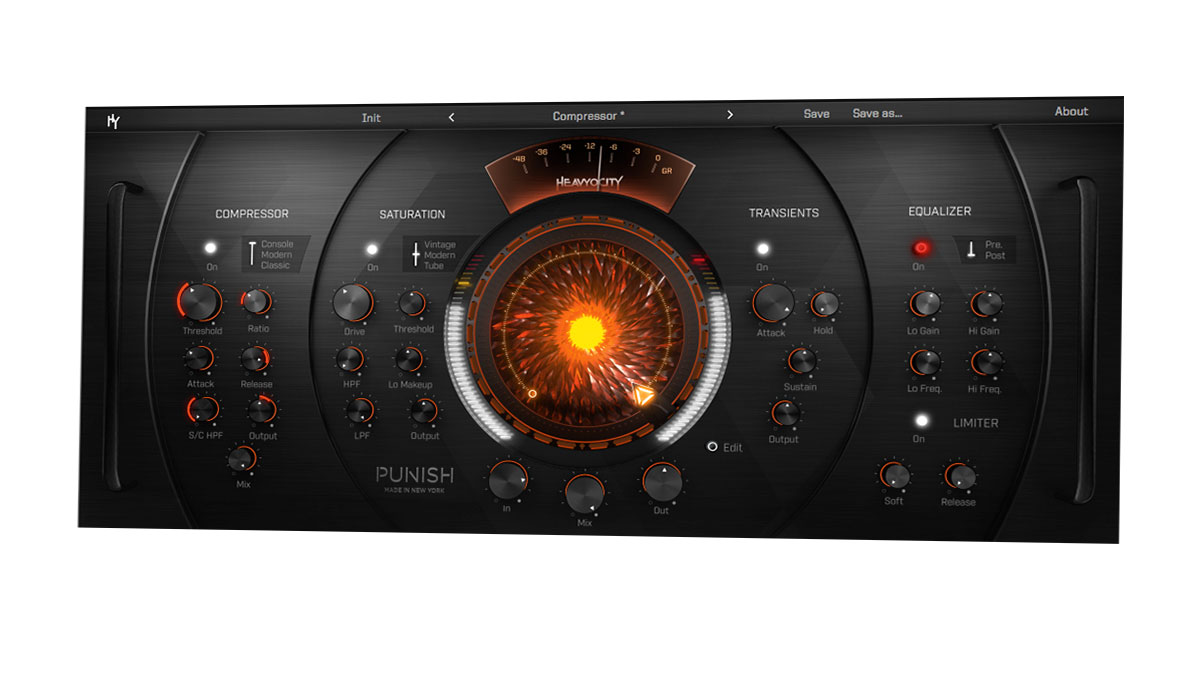MusicRadar Verdict
It may not be groundbreaking, but Punish combines excellent processing with simplicity to tweak or transform sounds.
Pros
- +
Five processors . Three distinct saturation effects. Three compression types.
Cons
- -
Very expensive. No onboard gate.
MusicRadar's got your back
Heavyocity's sample-based virtual instruments often benefit from one knob processors such as Twist and Punish, and the latter, which combines saturation, distortion and compression, has now been reworked into a fully fledged and fully tweakable plugin.
Punish (VST, AU, AAX) has five key processors - Compressor, Saturation, Transients, Equalizer and Limiter - and aside from the global Input, Output and Mix controls at the bottom, all knobs can be assigned to the rather artistic macro-style Punish Knob in the middle.
Punish includes three distinct compression types including both Class A (Console) and FET (Classic), three types of saturation including valve (Tube) and classic preamp overload (Vintage), a flexible Transient shaper with both attack level (Attack) and attack time (Hold), and flexible control of the output Limiter onset (Soft).
The signal flow is fixed as per the list above, but the EQ can be either post Transient, or at the input immediately pre-Compressor. There are also individual Output level controls for the dynamics processors, and individual section bypass buttons, which also double as peak
level indicators.
Pushing saturation
The three saturation modes deliver surprisingly different effects, and in all cases the combination of Drive and Threshold allows you to push things to audibly buzzy levels without impacting the gain structure elsewhere, which is very handy.
Subjectively, Vintage produces the most harmonics and is the most forward sounding, while Tube produces the least and is quite restrained. Modern mode sits somewhere between the two.
On the analyser, both Vintage and Tube produce prominent odd and even harmonics, but the tail-off is very different. Tube mode is dominated by the first few harmonics then sees a sudden drop off, while Vintage mode has a more gradual tail-off with many harmonic distortions. Modern mode is dominated by odd harmonics, and at higher drive levels delivers plenty more while always remaining less coloured than Vintage mode.
Finesse
Despite its name, Punish has many potential uses, as showcased by over 90 categorised presets including everything from subtle mastering (Light Push) to sonic destruction (Blown Cone). Digging deeper, the individual processors are extremely good. The Compressor, for example, can deliver lightning- fast transient squashing and snappy overshoot - great for beats and drums - but the sidechain high-pass filter (20 to 500Hz) also makes subtle compression very easy when working with submixes and masters.
The Saturation section includes a high-pass filter (20 to 500Hz), the frequencies above which are distorted. Combine this with independent level for the untouched low frequencies (Lo Makeup) and an overall low- pass filter (LPF) and you've got incredibly flexible saturation that can add edge to vocals, character to clean bass or simply grunge up whatever you like. Finally, the Transient processor's Hold control helps extend the audible transient - particularly effective when emphasising the attack and sustain on drums, for example.
The big selling point here is the main Punish macro knob and its ability to control multiple parameters quickly and easily. Again, the presets demonstrate this admirably, but setting up your own parameter modulations from scratch is also a doddle.
With the Edit button active, dragging on a knob creates a white halo (red when not in edit mode) with a black line marking the current parameter setting, overriding the actual knob position. The black line sits right in the middle of the halo travel when the Punish knob is at 12 o'clock, and both regular and inverted parameter control can be achieved. You may sometimes need to switch in and out of Edit mode to adjust the actual knob position, but this is pretty straightforward.
Overall, Punish is a great plugin, built from excellent component processors that can both transform and finesse your sounds; and although it could benefit from an inbuilt gate, and it's quite expensive, we're not going to let that get in the way of full marks. Bravo!
Computer Music magazine is the world’s best selling publication dedicated solely to making great music with your Mac or PC computer. Each issue it brings its lucky readers the best in cutting-edge tutorials, need-to-know, expert software reviews and even all the tools you actually need to make great music today, courtesy of our legendary CM Plugin Suite.
“Built from the same sacred stash of NOS silicon transistors and germanium diodes, giving it the soul – and snarl – of the original”: An octave-fuzz cult classic returns as Jam Pedals resurrects the Octaurus
What’s the buzz? Meet Yellowjacket, Cherry Audio's recreation of EDP’s trend-setting Wasp from 1978
“A fabulous trip through all eight songs by 24 wonderful artists and remixers... way beyond anything I could have hoped for”: Robert Smith announces new Cure remix album











